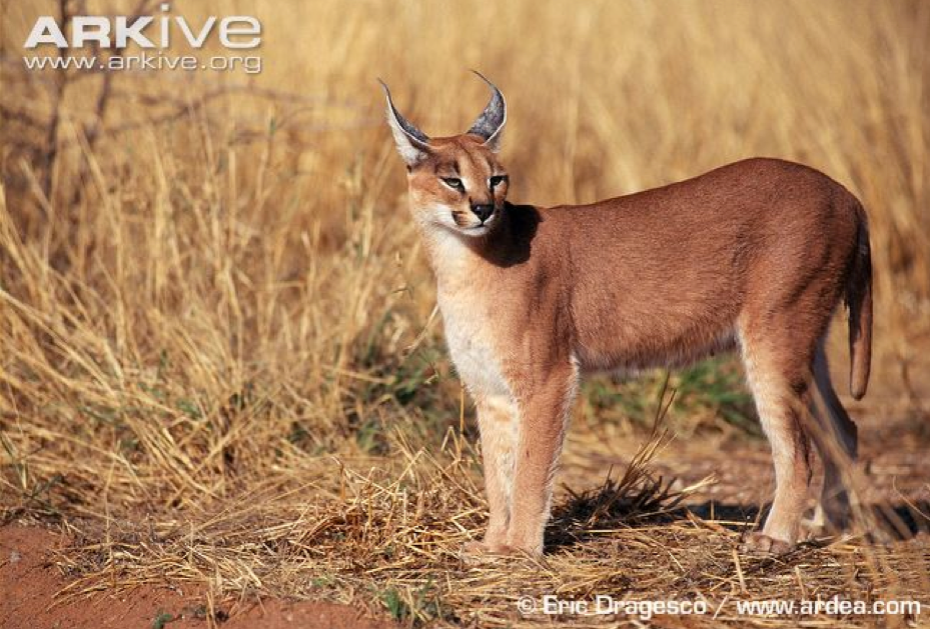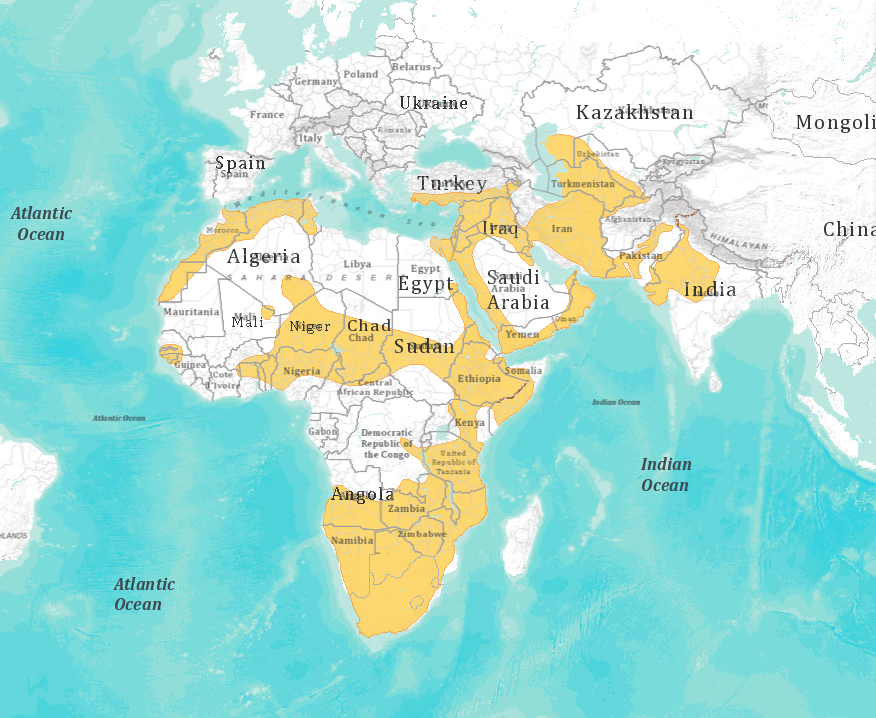The caracal, Caracal caracal (Schreber, 1776), is a medium-sized, solitary feline weighing between 8 and 20 kg for a lengh of 60 to 91 cm. It is closely allied with the African golden cat Caracal aurata and serval Leptailurus serval (Johnson et al. 2006, Elzirik et al. submitted). Caracals are also called African or desert lynx because of their long black tufted ears. That’s also where their name comes from, caracal meaning “black ear” in Turquish (karakulak). Their body colour varies from reddish-brown to tawny-grey, but occasionally entirely black individuals may occur.
The caracal is listed as Least Concern (LC) by the IUCN Red List because it is widespread and relatively common, particularly in southern and eastern Africa. Nonetheless, there have been range losses in northern Africa, and the species is of conservation concern in most of its Asian range (IUCN Cats Red List workshop, 2007).
Geographic range
Caracals are widely distributed across Africa, central Asia and south-west Asia into India. On the African continent, they are absent only from the equatorial forest belt and from much of the central Sahara, but they are present in the montane massifs of that desert. The historical range of the caracal mirrors that of the cheetah, and both coincide with the distribution of several small desert gazelles (Sunquist and Sunquist 2002). Caracals still occupy much of their historic range in Africa but have experienced substantial loss at the peripheries, particularly in north and west Africa (Ray et al. 2005).
Population
In sub-Saharan Africa, the caracal is common in parts of its range, especially in South Africa and southern Namibia where it is expanding into new, and recolonizing vacant, areas; however, in central and West Africa, where they are largely absent, densities are apparently lower, possibly due to finer partitioning of resources in a more diverse carnivore community (Stuart and Stuart in press). Avenant and Nel (1998) recorded a density of 0.23-0.47 caracal/km² in the West Coast N.P. in the Western Cape of South Africa.
In north Africa, the caracal is considered threatened (Stuart and Stuart in press), and rare in the Central Asian republics and India (Nowell and Jackson 1996). The population trend is unknown.
Habitat and ecology
The caracal occupies a wide variety of habitats from semi-desert to relatively open savanna and scrubland to moist woodland and thicket or evergreen/montane forest, but favours drier woodland and savanna regions with lower rainfall and some cover (Stuart and Stuart in press). While drier open country is preferred, they are absent from true desert and are usually associated with some form of vegetative cover (Sunquist and Sunquist 2002). They range up to 2500 m and exceptionnaly 3300 m in the Ethiopian Highlands (Ray et al. 2005).
Caracals prey mainly on small- to medium-sized mammals, from small murids to antelope up to 50 kg, but they will also take birds, reptiles, invertebrates, fish and some plant matter (Stuart and Stuart in press). Caracals often scavenge (Nowell and Jackson 1996).
Home ranges are large in arid areas, with the home ranges of three males averaging 316.4 km² on Namibian ranchland (Marker and Dickman 2005). In Saudi Arabia, a radio-tracked male ranged over 270 km² to 1,116 km² in different seasons (Van Heezik and Seddon 1998), while in an Israeli study, home ranges of males averaged 220.6 km² (Weisbein and Mendelssohn 1990). Male home ranges in better-watered environments of South Africa are smaller (two males averaged 26.9 km² in West Coast National Park: (Avenant and Nel 1998), and female ranges are considerably smaller than males (Stuart and Stuart in press).
Major threats
As caracals are capable of taking small domestic livestock, they are often subject to persecution. Stuart (1982) recorded that over the years 1931-1952 an average of 2,219 caracals per year were killed in control operations in the Karoo, South Africa. Similarly, Namibian farmers responding to a government questionnaire reported killing up to 2,800 caracals in 1981 (Nowell and Jackson 1996). Brand (1989) found that caracals were responsible for the loss of up to 5.3 domestic stock per 100 km² per annum in the former Cape Province of South Africa. Severity of depredation appears to be dependent on the availability of wild prey and husbandry techniques (Stuart and Stuart in press).
Habitat destruction (agriculture and desertification) is a significant threat in central, west, north and northeast Africa where caracals are naturally sparsely distributed (Ray et al.2005). It is also likely to be the main threat in the Asian part of its range (Sunquist and Sunquist 2002).
List of threats:
– Agriculture and aquaculture : annual and perennial non-timber crops, agro-industry farming
– Livestock farming and ranching: nomadic grazing, small-holder grazing ranching or farming
– Biological resource use: hunting and trapping terrestrial animals, unintentional effects (species is not the target), persecution, control
Conservation actions
Populations in Asian range states are included in CITES Appendix I; populations in African range states are included on Appendix II. Hunting of the species is prohibited in Afghanistan, Algeria, Egypt, India, Iran, Israel, Jordan, Kazakhstan, Lebanon, Morocco, Pakistan, Syria, Tajikistan, Tunisia, Turkey, Turkmenistan, and Uzbekistan (updated from Nowell and Jackson 1996). In sub-Saharan Africa, the caracal is protected from hunting in about half of its range states (Nowell and Jackson 1996). In Namibia and South Africa, the caracal is classified as a Problem Animal, which permits landowners to kill the species without restriction; nonetheless, caracal have persisted and remain widespread.
Caracal are present in many large, and well-managed protected areas, across their vast range.
Source: IUCN Red List




